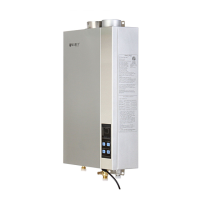3938
Install proper drainage for discharge of temperature and pressure relief valves per
local code when relief occurs and do not reduce or restrict line. Discharge line shall
be installed to allow complete drainage of both valve and line. See the page for relief
valve discharge.
Do not place a valve between the combination temperature and pressure relief
valve and the water heater.
Improper venting of a water heater can result in excessive levels of
Carbon Monoxide which can result in severe injury or death!
This water heater must be vented in accordance with the “Venting of
Equipment” section of ANSI Z223.1 / NFPA 54 National Fuel Gas
Code – latest versions, or in Canada, the most recent version of
CAN/CGA B149.1 Natural Gas and Propane Installation Code. In
additional, all installations must completely comply with all
applicable local building codes.Failure to comply can result in
equipment failure, fire, personal injury or death!
Use only stainless steel vent materials with this model! Plastic vent
systems are not compatible and the failure of the vent system could
result indamage, equipment failure, personal injury or death.
- For best results always minimize the length of the vent system. Keep the vent pipe
routing as short and straight as possible.
- The water heater vent must not be combined with the vent from any other gas
appliance or vent stack.
- The water heater vent must not be connected to a chimney.
- You must use vent components that are certified for use with this water heater as
indicated within this manual. Do not combine components from multiple
manufacturers.
Ensure any leak check solution is non-corrosive and is completely
rinsed from the piping after leak check is complete.
Corrosion of the gas piping and subsequent leaks could occur.
Never use flammable solutions or an open flame to test for gas leaks!
1. All piping, including soldering material, and components connected to this heater
shall be approved for use in potable water systems.
2. If the heater has ever been previously used for heating non-potable water, never
install the heater later into a potable water system.
3. The installation of manual shutoff valves, drain valves and unions are
recommended. A professional should review each installation and ensure adequate
ability to isolate, drain, and disconnect heater for service needs.
4. Connect suitable piping from water supply to the water heater. Note, water heater
connections are ½” NPT.
5. Purge the water line to remove debris and air. Debris can plug and damage the
heater.
6. Test water connections for leaks. Turn on water and purge water through the
water heater and system. Flow for 1-2 minutes. Ensure all air is eliminated.
7. After filling and flushing the system, check the inlet water filter for debris and clean
as required.
8. Consider insulation on hot water piping for energy conservation and personal
protection. Do not insulate the pressure relief valve!
This unit requires an approved temperature and pressure relief
valve. For protection against excessive temperatures and pressure,
install temperature and pressure protective equipment required by
local codes. The relief valve must be installed near the hot water
outlet and must comply with Standard for Relief Valves for Hot Water
Supply Systems, ANSI Z21.22 CSA 4.4.

